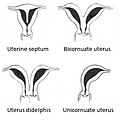Uterus didelphys
| Uterus didelphys | |
|---|---|
| Uterus didelphys 0001.jpg | |
| Synonyms | Double uterus |
| Pronounce | N/A |
| Specialty | N/A |
| Symptoms | None, or dysmenorrhea, dyspareunia, infertility |
| Complications | Miscarriage, preterm birth |
| Onset | Congenital |
| Duration | N/A |
| Types | N/A |
| Causes | Müllerian duct anomaly |
| Risks | N/A |
| Diagnosis | Ultrasound, MRI, Hysterosalpingography |
| Differential diagnosis | N/A |
| Prevention | N/A |
| Treatment | Surgery, Reproductive assistance |
| Medication | N/A |
| Prognosis | N/A |
| Frequency | Rare |
| Deaths | N/A |
Uterus didelphys, also known as double uterus, is a rare congenital condition where a female has two separate uterine cavities, each with its own cervix, and often a double or septate vagina. This condition is a type of Müllerian duct anomaly, which occurs during fetal development when the paired Müllerian ducts fail to fuse properly.
Anatomy and Development[edit]
During normal fetal development, the Müllerian ducts fuse to form a single uterine cavity. In uterus didelphys, this fusion does not occur, resulting in two distinct uteri. Each uterus may have its own fallopian tube, and the condition can be associated with a double cervix and a longitudinal vaginal septum.
Symptoms and Diagnosis[edit]
Many women with uterus didelphys are asymptomatic and may not be aware of the condition until they undergo a pelvic examination or imaging for other reasons. Symptoms, if present, can include dysmenorrhea (painful menstruation), dyspareunia (painful intercourse), and infertility.
Diagnosis is typically made through imaging studies such as ultrasound, MRI, or hysterosalpingography. These imaging techniques can reveal the presence of two separate uterine cavities and help differentiate uterus didelphys from other Müllerian duct anomalies.
Complications[edit]
Women with uterus didelphys may experience complications during pregnancy, including a higher risk of miscarriage, preterm birth, and abnormal fetal positions. However, many women with this condition can have successful pregnancies.
Treatment[edit]
Treatment is not always necessary unless the condition causes significant symptoms or complications. Surgical intervention may be considered to remove a vaginal septum if it causes obstruction or discomfort. In cases of infertility or recurrent pregnancy loss, reproductive assistance such as in vitro fertilization (IVF) may be recommended.
Also see[edit]
References[edit]
<references group="" responsive="1"></references>
External links[edit]
- [Link to a reputable medical resource]
-
Uterus didelphys
-
Uterine malformation
Ad. Transform your life with W8MD's Budget GLP-1 injections from $75


W8MD offers a medical weight loss program to lose weight in Philadelphia. Our physician-supervised medical weight loss provides:
- Weight loss injections in NYC (generic and brand names):
- Zepbound / Mounjaro, Wegovy / Ozempic, Saxenda
- Most insurances accepted or discounted self-pay rates. We will obtain insurance prior authorizations if needed.
- Generic GLP1 weight loss injections from $75 for the starting dose.
- Also offer prescription weight loss medications including Phentermine, Qsymia, Diethylpropion, Contrave etc.
NYC weight loss doctor appointmentsNYC weight loss doctor appointments
Start your NYC weight loss journey today at our NYC medical weight loss and Philadelphia medical weight loss clinics.
- Call 718-946-5500 to lose weight in NYC or for medical weight loss in Philadelphia 215-676-2334.
- Tags:NYC medical weight loss, Philadelphia lose weight Zepbound NYC, Budget GLP1 weight loss injections, Wegovy Philadelphia, Wegovy NYC, Philadelphia medical weight loss, Brookly weight loss and Wegovy NYC
|
WikiMD's Wellness Encyclopedia |
| Let Food Be Thy Medicine Medicine Thy Food - Hippocrates |
Medical Disclaimer: WikiMD is not a substitute for professional medical advice. The information on WikiMD is provided as an information resource only, may be incorrect, outdated or misleading, and is not to be used or relied on for any diagnostic or treatment purposes. Please consult your health care provider before making any healthcare decisions or for guidance about a specific medical condition. WikiMD expressly disclaims responsibility, and shall have no liability, for any damages, loss, injury, or liability whatsoever suffered as a result of your reliance on the information contained in this site. By visiting this site you agree to the foregoing terms and conditions, which may from time to time be changed or supplemented by WikiMD. If you do not agree to the foregoing terms and conditions, you should not enter or use this site. See full disclaimer.
Credits:Most images are courtesy of Wikimedia commons, and templates, categories Wikipedia, licensed under CC BY SA or similar.
Translate this page: - East Asian
中文,
日本,
한국어,
South Asian
हिन्दी,
தமிழ்,
తెలుగు,
Urdu,
ಕನ್ನಡ,
Southeast Asian
Indonesian,
Vietnamese,
Thai,
မြန်မာဘာသာ,
বাংলা
European
español,
Deutsch,
français,
Greek,
português do Brasil,
polski,
română,
русский,
Nederlands,
norsk,
svenska,
suomi,
Italian
Middle Eastern & African
عربى,
Turkish,
Persian,
Hebrew,
Afrikaans,
isiZulu,
Kiswahili,
Other
Bulgarian,
Hungarian,
Czech,
Swedish,
മലയാളം,
मराठी,
ਪੰਜਾਬੀ,
ગુજરાતી,
Portuguese,
Ukrainian

